Tillandsia botterii
Click thumbnails for full size, scaled to a new window.
Tillandsia botterii
(In taxon list with "ii" ending, but correct latin suffix it should be botteri.)
Mexico.
See also suspect images under T. tricolor.

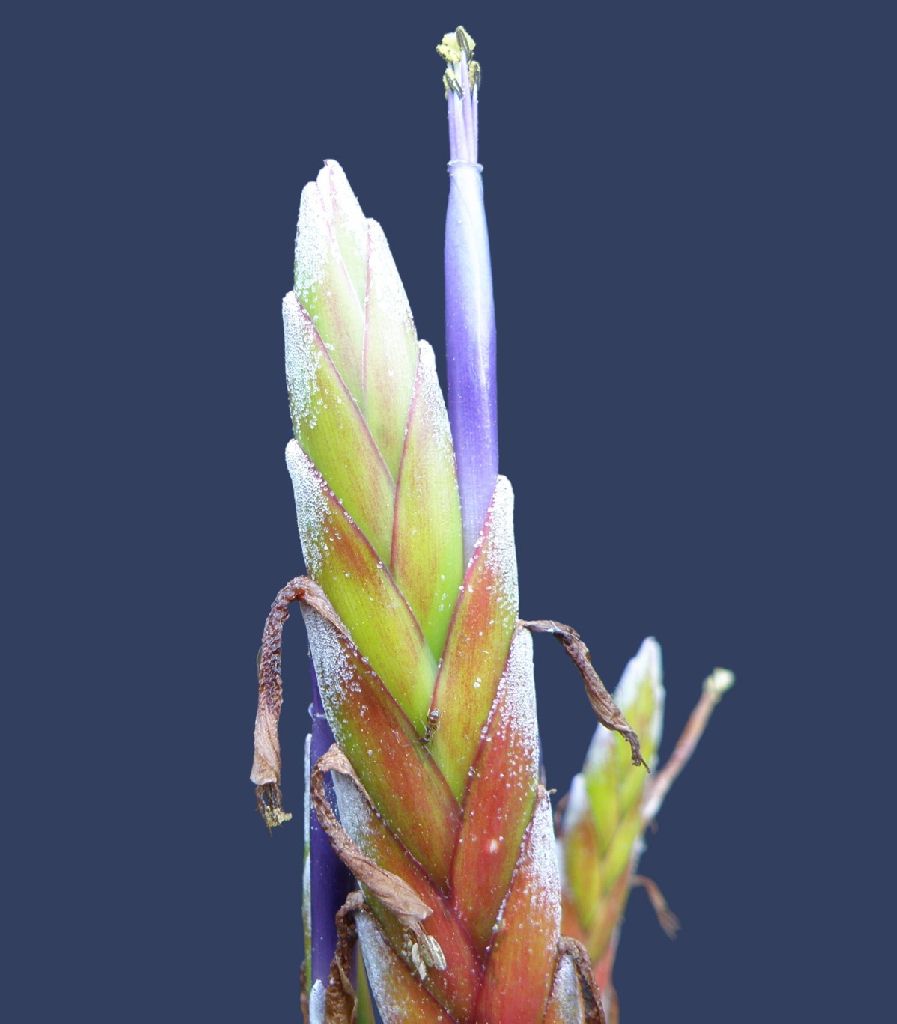


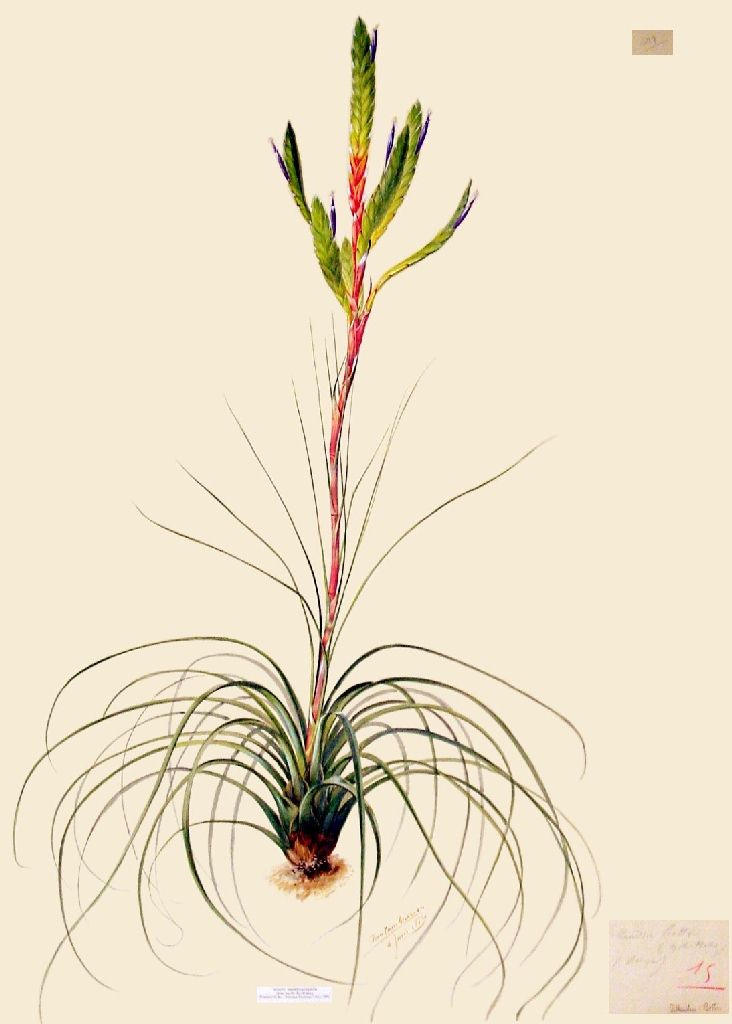
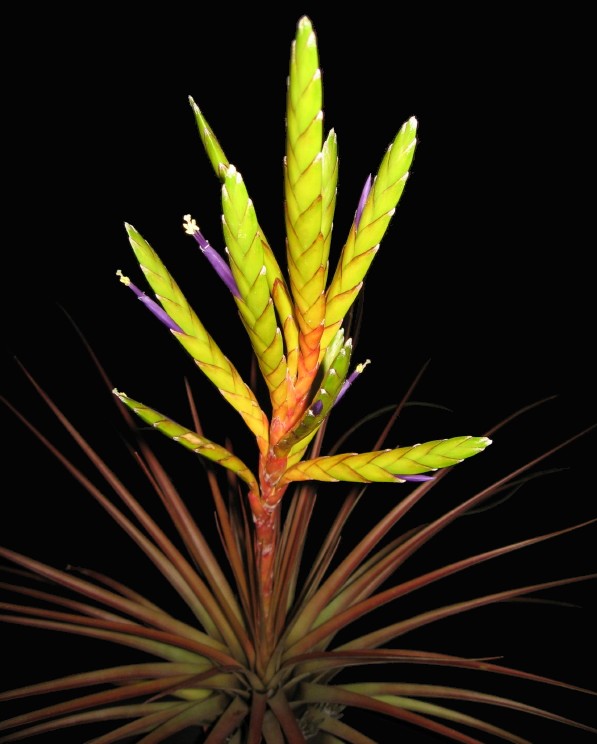

| Derek Butcher 10/12. Was clavispica |
Type specimen, Kew Gardens. From D.Butcher. |
as per Howard Martin |
as per Peter Tristram |
Derek Butcher ... "The photo under "ex clavispica" is a Marie Selby photo and they were the ones to change the name. I'm not so certain.
While on the subject of T. botteri, I doubt Brenton Cadd's T. botteri because the inflorescence does not have fasciculate branching but seek others opinion."
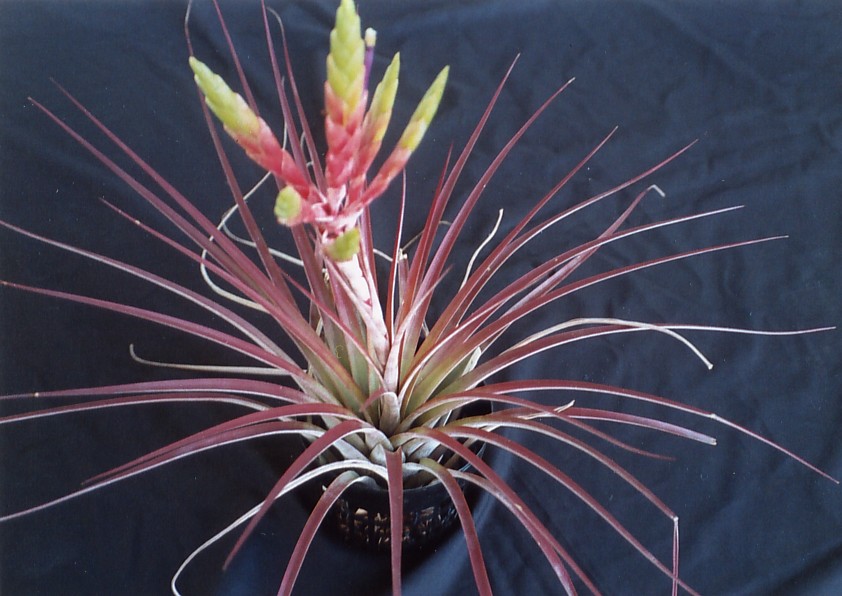
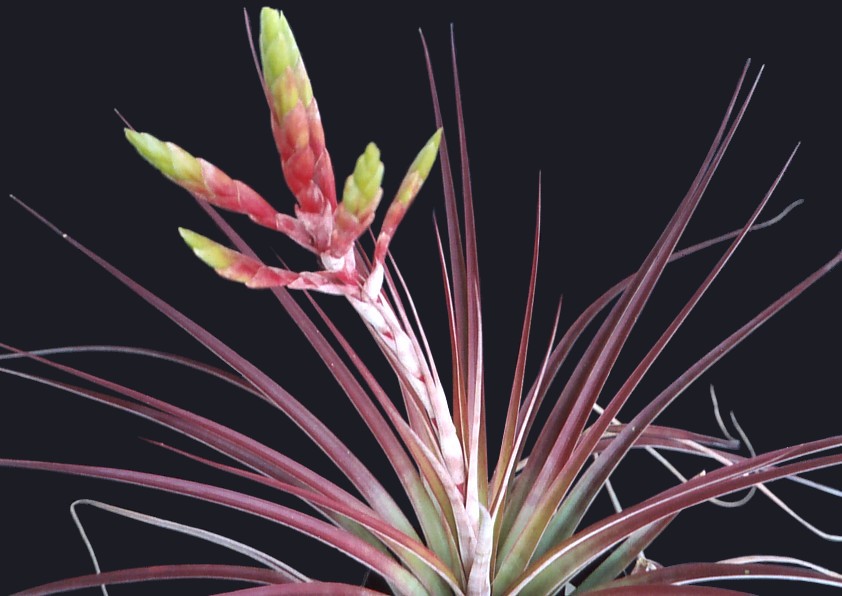

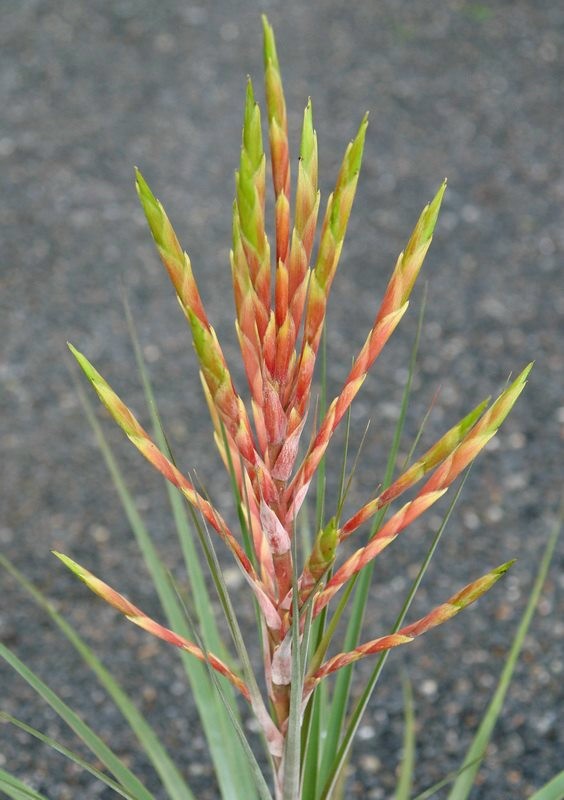
| as per Cathcart/Tarver |
as per Dennis Cathcart |
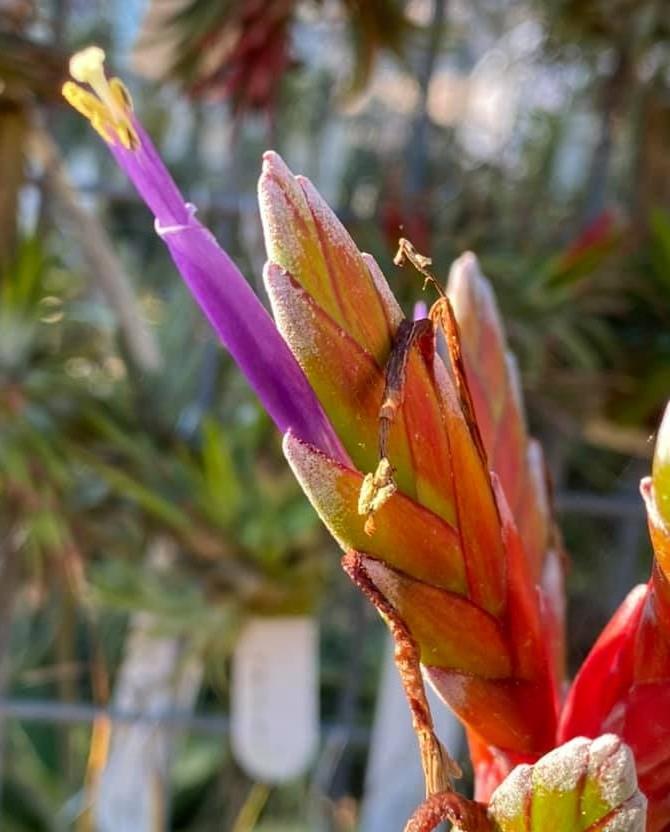
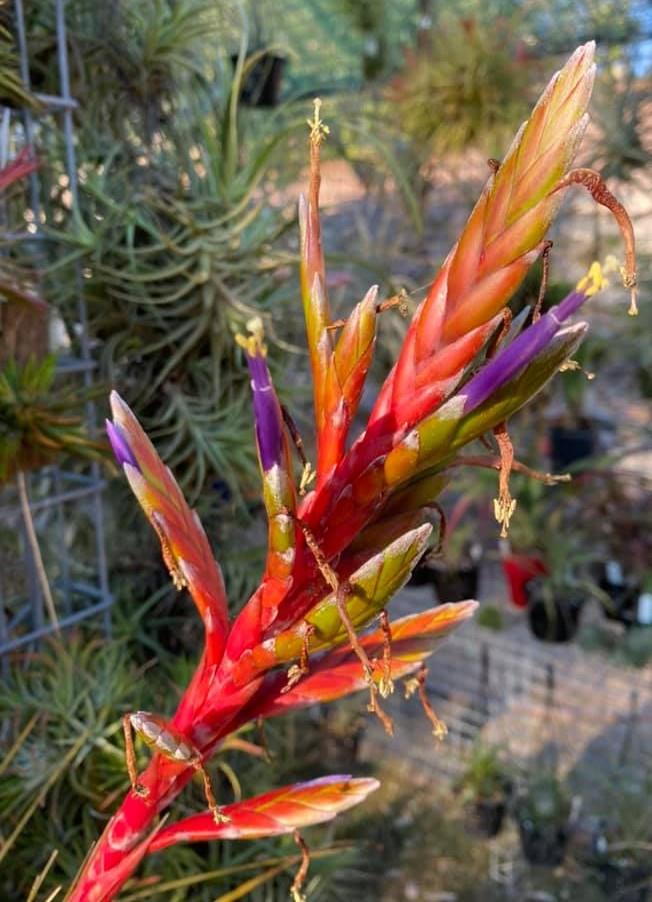
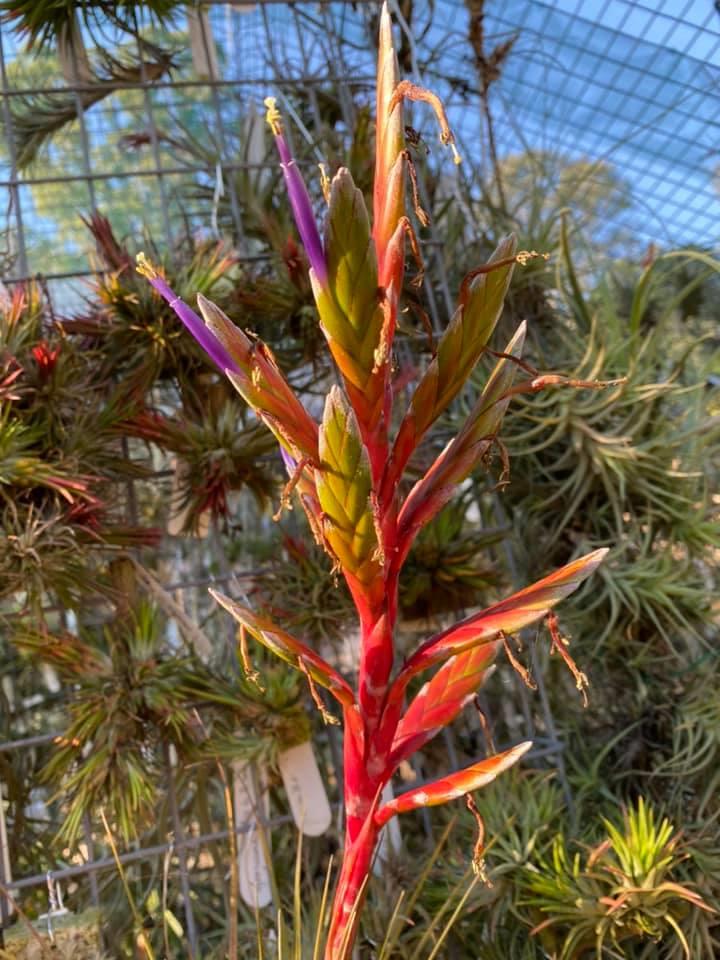
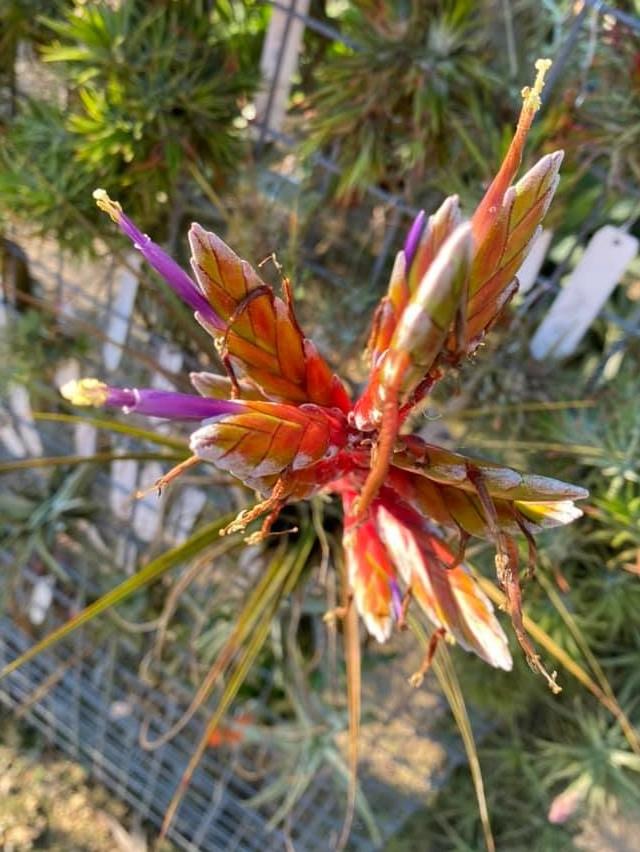
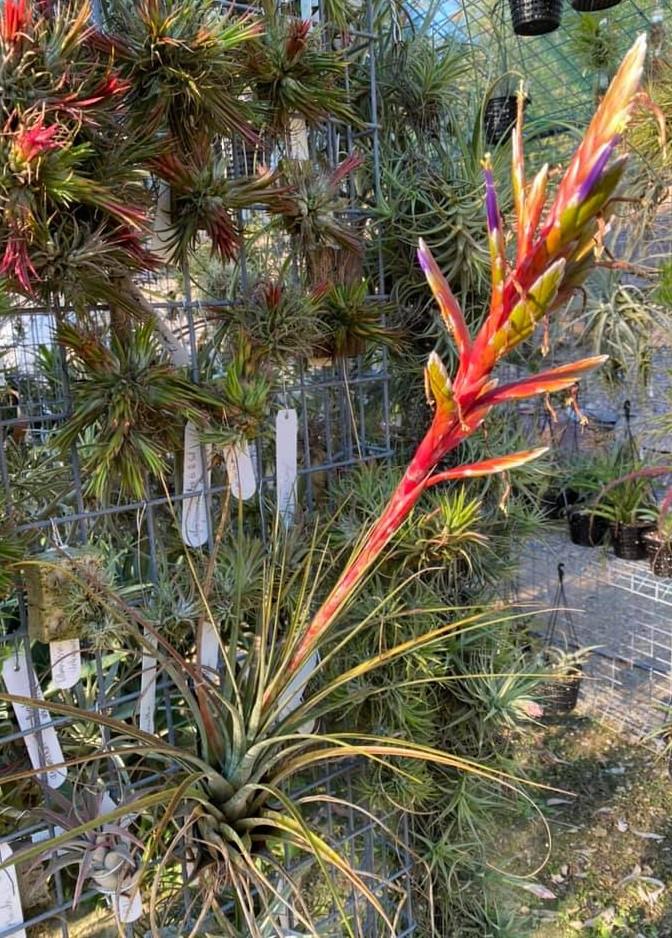 Dale Dixon ... "Tillandsia botterii (subg. Tillandsia) is endemic to Mexico and occurs in a variety of habitats including deciduous forests, pine forest and riparian vegetation between 450-1560 m elevation.
Dale Dixon ... "Tillandsia botterii (subg. Tillandsia) is endemic to Mexico and occurs in a variety of habitats including deciduous forests, pine forest and riparian vegetation between 450-1560 m elevation.
The species epithet honours Mateo Botteri (1808-1877), an Italian naturalist who in 1853 was sent to Mexico by the Royal Horticultural Society of London to collect plants. He collected plants as well as animal, cultural and artistic specimens all destined for Europe to enhance the knowledge of Mexico's natural and cultural history.
This is a stunning species and it positively glows in the sun. The red, orange and yellow-green of the inflorescence all work together to give this species a special look. And to ‘put the icing on the cake’ the tips of the floral bracts are heavily ‘frosted’ with lepidote scales.
My plant is suspended on aluminium craft wire and hangs high on an internal wall in the TillHouse where it receives full exposure to the sun. This plant has been in my collection since June 2018."
Dale Dixon ... "These two Tillandsias have had their ID queried on an international Tillandsia page. First one was bought as T. botterii and the second one as T. rodrigueziana."
Peter Tristram ... "T. botteri. Plants were imported long back as tricolor but with multibranched spikes, ex Alfredo Lau, ex Vera Cruz area, in my case. We, at a TPE decided that these would be closer to botteri. Check the DVD. The Yanks sell a different plant with that name, not botteri either IMO. Harry Luther agreed re our decision on botteri.
The rodrigueziana could be one of mine, ex Selby, which I thought could be a large paraisoensis at one stage. (If not, then it’s very similar!) That was before I had any verifiable paraisoensis. Renate actually had exactly the same plant in her car when I got a lift to a DBG conference (2006) and it was decided to be best left as rodrigueziana. I believe provenance played a part too. rodrigueziana is like fasciculata - so variable and likely a bunch of species lumped. Harry simply referred to the groups as hybrid swarms. I’m sure Pam knows more about the Mexican stuff than any of us!
I also remember these ‘botteri’ lookers arriving as rodrigueziana. It’s been a very confused lot for many years. Unfortunately, with most US suppliers, provenance wasn’t included, the main exception being BRT."


TILLANDSIA BOTTERI E. Morren ex Baker, Handb. Bromel. 183. 1889.
Treated as a synonym of T. tricolor in S&D but resurrected here as T. botterii (incorrect suffix!) by Espejo-Serna et al in Flora de Vera Cruz, fasc136, Bromeliaceae, 147-50. Aug 2005 and Selbyana 25(1): 54. 2004
Type: Mexico, drawing of professor Morren's, made from a plant sent to him by M. Devansaye in june 1879 (Holotype: K!).
Vriesea botterii hort. ex Regel, Gartenflora 33: 293, 1884, nom. nud.
Common name. Gallito; tencho.
Plants rosette, epiphytic, flowering 43-70 cm high, the rosettes of a tank type, up to 60 cm diam., in their widest part, caespitose to solitary, stemless.
Leaves numerous,
sheaths brown to purple, lustrous, oblong to ovate, 4-8 cm long, 3-4 cm wide, densely punctulate-lepidote on both surfaces,
Blades green to green-yellowish, very long triangular, 23-60 cm long, 1.5-2.6 mm wide at the base, densely punctulate-lepidote on both surfaces, attenuate and curved outwards at the apex.
Inflorescence terminal, erect, fasciculate-compound, bipinnate, with 4-12 erect spikes,
Inflorescence (when spikes exceed 7, inflorescence polystichously once-branched with stipitate branches, remote at the base and dense at distal end –Butcher and Gouda!).
Scape cylindrical, 28-41 cm long, 2.5-4 mm diameter, covered totally by the sheaths of the bracts;
Scape bracts the lower ones green, the upper ones red or yellow, leaflike, very similar to the leaves in form and size and decreasing gradually toward the distal part of the scape, 6-35 cm long,
Spikes complanate 11-20 cm, 1.7-2 cm wide, pedunculate, the peduncle bract, 1.4-5 cm long;
Primary bracts red to yellow, sheathlike, 2.7-5.5 cm long;
floral bracts the lower ones red, the upper ones green, ovate, 3-4 cm long, 1.9-2.3 cm wide when unfolded and smoothed out, but longer than the internodes, imbricate, flat, lustrous, carinate, lepidote toward the apex, acute to acuminate at the apex;
Flowers distichous, erect, 6-12 per spike, actinomorphic, tubular, subsessile;
Sepals green, oblong to oblong-elliptic, 2.8-3 cm long, 5-5.5 mm wide, glabrous, acute to acuminate at the apex, the posterior pair carinate and connate to almost all their length
Petals free, violet in the top half, white in the basal, oblong-spatulate, 4.9-5.5 cm long, 5-6 mm wide, acute at the apex;
Stamens unequal, but longer than the petals, filaments filiform, white in their bottom ¾ and dark violet and flattened in their upper ¼, 4-5.7 cm long, the anthers black, oblong to ellipsoid, ca. 3 mm long; green,
Ovary ovoid, 8-10 mm long, ca. 3 mm diameter, style white and filiform in their bottom ¾, dark violet in their upper ¼, ca. 5.5 cm long, the stigma violet.
Capsule not seen; seeds not seen.
Distribution. Endemic to Veracruz.
Examples examined. Mun. Huayacocotla, Potrero Seco, camino al rio Tanatitlan, L. Ballesteros & J. I. Calzada 238 (IEB, MEXU, XAL); Mun. Tlaltetela, cerro calizo al NW de la Barranca del Monterrey, M. Chazaro et al. 4371 (XAL); Mun. Coatepec, ca. 5 km despues de Coatepec, rumbo a Jalcomulco, en la desviacion a Mahuixtlan, A. Espejo & A. R. Lopez-Ferrari 6402 (UAMIZ); Mun. Naolinco, ca. 19 km despues (al WNW) de Actopan, rumbo a Xalapa, A. Espejo et al. 6725 (UAMIZ(2)); Mun. Jalcomulco, canyon walls near puente Los Pescados, Huatusco to Chignahuapan, L. Hromadnik 14323 (WU(3)); Mun. Fortin, El Corazon, C. Lopez s. n. (XAL); Mun. Coatepec, Isleta Chica, V. E. Luna 765 (XAL), Mun. Coatepec, Tuzamapan, 5 km al SE de Tuzamapan, 1062 (XAL); Mun. Comapa, barranca de Panoaya, 1.5 km al NE de El Coyol, M. E. Medina & M. Ortiz 825 (XAL); Mun. Coatepec, 1 km SE of main Xalapa-Huatusco hwy., 5 km SW of bridge over rio Los Pescados, 5 km (by air) SE of Tuzamapan, M. Nee & K Taylor 26032 (XAL); Mun. Rio Blanco, 3 km al E de Rio Blanco, rumbo a Acultzingo, L. I. Nevling & A. Gomez-Pompa 2350 (MEXU); Mun. Xalapa, Xalapa, J. N. Rose & R. Hay 318 (MEXU); Mun. Actopan, cerca San Antonio Paso del Toro, ca. 15 km al N de Actopan, S Galen Smith 6051 (XAL); Mun. Coatepec, carretera a Huatusco, P. Valdivia 2007 (XAL).
Altitude. 450-1,560 m snm.
Type of vegetation. Forest low deciduous forest; deciduous forest; pine tree forest and riverbank vegetation.
Flowering. Seemingly throughout whole year.
Tillandsia botteri is frequently confused, particularly in herbarium material, with T. fasciculata but it is clearly different from this because of the structure of the inflorescence and in the characteristics of the spikes. Also, this species was considered for a long time as a synonym of T. tricolor.
Tillandsia botteri E. Morren ex Baker, Handb. Bromel. 183. 1889. Type. Mexico, Morren Icon (K).
109. T. BOTTERI E. Morren (M.D.).-Leaves about 80, densely rosulate, linear- setaceous from an ovate base an inch broad, a foot long, ½ in. broad low down, spreading, rigidly coriaceous, thinly lepidote. Peduncle a foot long; bract-leaves with long setaceous free points. Spikes 3-7, ascending, dense, distichous, crowded, 3-6 in. long, an inch broad; branch-bracts small, ovate ; flower bracts ovate, acute, 1-1¼ in. long, lower red, upper green. Calyx shorter than the bract. Petals lilac, convolute in a cylindrical tube an inch long, shorter than the stamens.
Habitat Mexico. Described from Morren's drawing, made from a plant sent to him by M. Devansaye in June, 1879. Scarcely more than a variety of T. fasciculata. A Cuban plant (C. Wright 680!) approaches it closely.
Updated 04/11/23

















